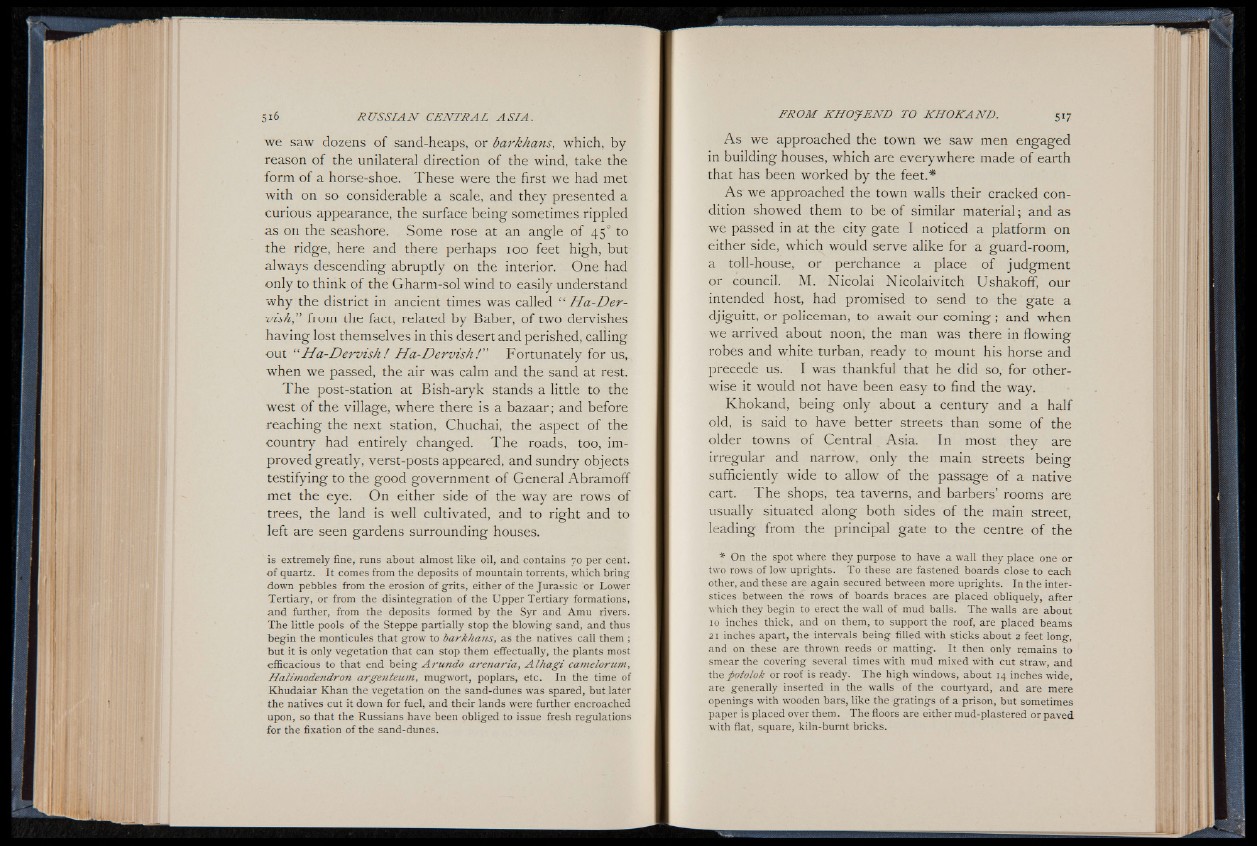
we saw dozens of sand-heaps, or barkhans, which, by
reason of the unilateral direction of the wind, take the
form of a horse-shoe. These were the first we had met
with on so considerable a scale, and they presented a
curious appearance, the surface being sometimes rippled
as on the seashore. Some rose at an angle of 450 to
the ridge, here and there perhaps 100 feet high, but
always descending abruptly on the interior. One had
only to think of the Gharm-sol wind to easily understand
why the district in ancient times was called “ H a-D ervish,”
from the fact, related by Baber, of two dervishes
having lost themselves in this desert and perished, calling
out “Ha-Dervish! H a-D ervish!" Fortunately for us,,
when we passed, the air was calm and the sand at rest.
The post-station at Bish-aryk stands a little to the
west of the village, where there is a bazaar; and before
reaching the next station, Chuchai, the aspect of the
country had entirely changed. The roads, too, improved
greatly, verst-posts appeared, and sundry objects
testifying to the good government of General Abramoff
met the eye. On either side of the way are rows of
trees, the land is well cultivated, and to right and to
left are seen gardens surrounding houses.
is extremely fine, runs about almost like oil, and contains 70 per cent,
o f quartz. It comes from the deposits of mountain torrents, which bring
down pebbles from the erosion of g rits, either of the Jurassic or Lower
Tertiary, or from the disintegration of the Upper Tertiary formations,
and further, from the deposits formed by the Syr and Amu rivers.
The little pools of the Steppe partially stop the blowing sand, and thus
begin the monticules that grow to barkhans, as the natives call them ;
but it is only vegetation that can stop them effectually, the plants most
efficacious to that end being Arundo arenaria, A lh a g i camelorum,
Halimodendron argenteum, mugwort, poplars, etc. In the time of
Khudaiar Khan the vegetation on the sand-dunes was spared, but later
the natives cut it down for fuel, and their lands were further encroached
upon, so that the Russians have been obliged to issue fresh regulations
for the fixation of the sand-dunes.
As we approached the town we saw men engaged
in building houses, which are everywhere made of earth
that has been worked by the feet.*
As we approached the town walls their cracked condition
showed them to be of similar material; and as
we passed in at the city gate I noticed a platform on
either side, which would serve alike for a guard-room,
a toll-house, or perchance a place of judgment
or council. M. Nicolai Nicolaivitch Ushakoff, our
intended host, had promised to send to the gate a
djiguitt, or policeman, to await our coming ; and when
we arrived about noon, the man was there in flowing
robes and white turban, ready to mount his horse and
precede us. I was thankful that he did so, for otherwise
it would not have been easy to find the way.
Khokand, being only about a century and a half
old, is said to have better streets than some of the
older towns of Central Asia. In most they are
irregular and narrow, only the main streets being
sufficiently wide to allow of the passage of a native
cart. The shops, tea taverns, and barbers’ rooms are
usually situated along both sides of the main street,
leading from the principal gate to the centre of the
* On the spot where they purpose to have a wall they place one or
two rows of low uprights. To these are fastened boards close to each
other, and these are again secured between more uprights. In the interstices
between the rows of boards braces are placed obliquely, after
which they begin to erect the wall of mud balls. The walls are about
10 inches thick, and on them, to support the roof, are placed beams
21 inches apart, the intervals being filled with sticks about 2 feet long,
and on these are thrown reeds or matting. It then only remains to
smear the covering several times with mud mixed with cut straw, and
the fiotolok or roof is ready. The high windows, about 14 inches wide,
are generally inserted in the walls of the courtyard, and are mere
openings with wooden bars, like the gratings of a prison, but sometimes
paper is placed over them. The floors are either mud-plastered or paved
with flat, square, kiln-burnt bricks.